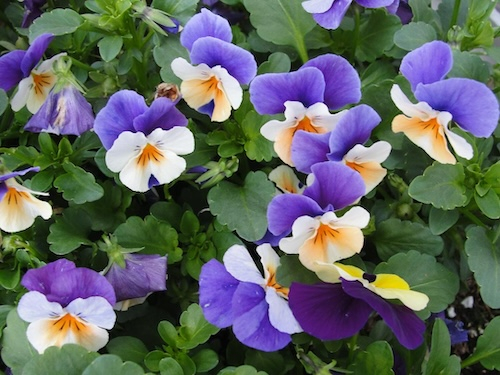
Violas are basically miniature pansies and are easy to grow.
November 13, 2025 - When the nights begin to cool and the first whiff of fall drifts through the air, I know it’s time for one of the most popular cool seasons flower combos: pansies and violas. These cheerful, cold-hardy flowers have been brightening up Texas winters for generations, offering a welcome splash of color when most other blooms are long gone.
Pansies and their smaller-flowered cousins, violas, are members of the violet family. Their name comes from the French word pensée, purportedly meaning “thought,” because the downward-facing flowers appear to nod as if lost in contemplation. Pansies were developed from European wild violets and became wildly popular in the Victorian era. Their friendly faces and wide range of colors, from soft pastels to deep velvety purples, have made them winter garden staples ever since.
In East Texas, pansies and violas thrive from October through April, making them ideal for cool-season beds, containers, and borders. They prefer full to partial sun and well-drained, organically enriched soil. If you have heavy clay, add compost or raised planting beds to keep their roots from staying wet. Plant them about six inches apart and water deeply after planting to help them establish before winter.
Pansies are annuals, prefer cool weather, and will survive light freezes with ease. In fact, they bloom best when daytime temperatures hover in the 50s and 60s. During harsh cold snaps, a frost cloth or other light covering will help protect them, but once the sun returns, they bounce back quickly.
The key to keeping pansies and violas blooming all winter is steady care. Fertilize with a slow-release, high-nitrogen fertilizer at planting and again in late winter to encourage fresh blooms. Deadhead faded flowers regularly to keep plants tidy and productive. Slugs, snails, and aphids occasionally show up, but they can be managed easily with hand-picking or organic pesticides.
While pansies are prized for their large, showy flowers, violas are often the tougher of the two. Their smaller blooms hold up better in rain and wind, and they tend to reseed lightly from year to year. Violas such as “Johnny Jump Ups” with their purple and yellow blooms, have charmed gardeners for centuries. I like mixing the two together for both contrast and endurance, pansies for bold color, violas for endurance.
Pansies and violas also provide more than just beauty. They’re edible, with a mild, sweet flavor that makes a colorful garnish for salads and desserts. Whether planted in mass displays, tucked around evergreens, or spilling from containers, pansies and violas never fail to brighten the season. Mrs. G loves them.
Greg Grant, Ph.D., is the Smith County horticulturist and Master Gardener coordinator for the Texas A&M AgriLife Extension Service in Tyler. He is the author of Texas Fruit and Vegetable Gardening, Texas Home Landscaping, Heirloom Gardening in the South, and The Rose Rustlers. You can read his “Greg’s Ramblings” blog at arborgate.com, read his “In Greg’s Garden” in each issue of Texas Gardener magazine (texasgardener.com), or follow him on Facebook at “Greg Grant Gardens” or “Pines, Pawpaws, and Pocket Prairies.” More science-based lawn and gardening information from the Texas A&M AgriLife Extension Service can be found at aggieturf.tamu.edu and aggie-horticulture.tamu.edu.









